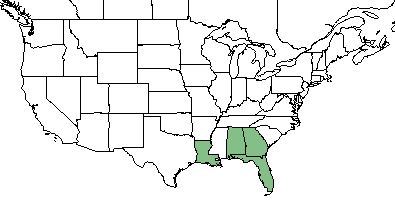Difference between revisions of "Zephyranthes treatiae"
(→Ecology) |
|||
| Line 31: | Line 31: | ||
==Ecology== | ==Ecology== | ||
===Habitat=== <!--Natural communities, human disturbed habitats, topography, hydrology, soils, light, fire regime requirements for removal of competition, etc.--> | ===Habitat=== <!--Natural communities, human disturbed habitats, topography, hydrology, soils, light, fire regime requirements for removal of competition, etc.--> | ||
| − | + | ||
| + | ===Phenology=== <!--Timing off flowering, fruiting, seed dispersal, and environmental triggers. Cite PanFlora website if appropriate: http://www.gilnelson.com/PanFlora/ --> | ||
| + | It flowers between Feburary and April, peaking in March.<ref>Nelson G. (15 December 2017) PanFlora. Retrieved from gilnelson.com/PanFlora/</ref> | ||
<!--===Seed dispersal===--> | <!--===Seed dispersal===--> | ||
<!--===Seed bank and germination===--> | <!--===Seed bank and germination===--> | ||
Revision as of 11:21, 15 December 2017
| Zephyranthes treatiae | |
|---|---|

| |
| Photo by John Gwaltney hosted at Southeastern Flora.com | |
| Scientific classification | |
| Kingdom: | Plantae |
| Division: | Magnoliophyta - Flowering plants |
| Class: | Liliopsida - Moncots |
| Order: | Liliales |
| Family: | Liliaceae |
| Genus: | Zephyranthes |
| Species: | Z. treatiae |
| Binomial name | |
| Zephyranthes treatiae S. Watson | |

| |
| Natural range of Zephyranthes treatiae from USDA NRCS Plants Database. | |
Common Name(s): zephyrlily,[1][2] Treat's zephyr-lily[2]
Contents
Taxonomic Notes
Synonym(s): Atamosco treatiae; Z. atamasca var. treatiae[1][2]
Description
Z. treatiae is a monoecious perennial forb/herb.[2]
Distribution
It can be found in southern portions of Georgia, south to central penisular Florida,[1][2] and occurrences in Alabama and Louisiana. In Florida, Z. treatiae is listed as a threatened species.[2]
Ecology
Habitat
Phenology
It flowers between Feburary and April, peaking in March.[3]
Conservation and Management
Cultivation and restoration
Photo Gallery
References and notes
- ↑ 1.0 1.1 1.2 Weakley A. S.(2015). Flora of the Southern and Mid-Atlantic States. Chapel Hill, NC: University of North Carolina Herbarium.
- ↑ 2.0 2.1 2.2 2.3 2.4 2.5 USDA, NRCS. (2016). The PLANTS Database (http://plants.usda.gov, 15 December 2017). National Plant Data Team, Greensboro, NC 27401-4901 USA.
- ↑ Nelson G. (15 December 2017) PanFlora. Retrieved from gilnelson.com/PanFlora/